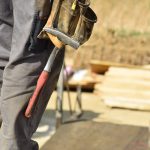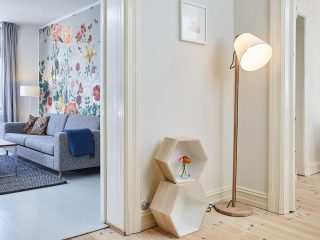The use of sustainable building materials, where possible, was also a charter condition. Whilst choosing hemp/lime as the wall material would provide a solution to some of these challenges, it was not a decision to be taken lightly, and was possibly the biggest potential risk in the project. Fortunately, Brendan had already completed a hemp/lime introductory building course and could see the inherent natural advantages of using the material to build the walls of a house. He went ahead and designed his home, hiring a local draughtsman to put his vision on paper.
Hemp-lime (‘hempcrete’) as a building material
While hemp is also a name for cannabis, don’t let that put you off! Hemp is one of the earliest domesticated plants known and one of the fastest growing. As a crop, it’s very environmentally friendly as it requires few pesticides and no herbicides. It also absorbs CO2 gas as it grows, retaining the carbon and releasing the oxygen. In fact industrially grown hemp is an annual crop that has many uses in manufacturing, health and medicine; for building, the wood part of the hemp stalk (hurd) is used. Botanically as well as chemically, its woody core is comparable to hardwood.
Hemp has been around for many years, and is still used today. Queen Elizabeth I decreed that all farmers, during her reign, were obliged to grow hemp on their farms. Until the 1800s, hemp was used to produce rope, cloth, food, lighting oil and medicine and was one of the main cultivated plants throughout the western world. Guttenberg’s first Bible was even published upon hemp paper and currently hemp fibres are used to manufacture bank notes.
Its insulating properties are similar to sheep wool or rock-wool insulation, and it is free of the embodied energy associated with man-made insulation products. It also has more thermal mass than sheep wool, rock-wool or timber, but yet is more responsive to heating than block, brick or concrete. As well as being breathable, hemp is known as one of the least allergenic materials available, and is used in clothing for people with sensitive skin.
Lime, meanwhile, absorbs carbon dioxide as it sets and during its lifetime as a building material. It’s going through a process of turning back into rock and this means that over time the building gets stronger, prolonging its lifetime. Lime also adds fire resistance to the walls.
[adrotate banner="58"]The combination of lime and hemp has many advantages as a building material, both in construction and in the use of the dwelling. The lime brings the advantages of a binder, hardener and preservative from rodents, fungi and micro-organisms. As a finished material in walls, hemp/lime is quite hygroscopic, which means it can absorb and release moisture to create an even indoor humidity, unlike many man-made materials, including concrete. A plastered hemp/lime mix also has quite a low air permeability, one of the most important criteria in meeting our current building regulations.
Also, because hemp is a completely natural material, it does not require weather protection during the construction of the walls. This is an added plus – particularly in an Irish climate! – as compared to concrete or even straw bales and timber which can be damaged if left exposed. When blended with lime, hemp can be strong enough to replace traditional wall materials of normal thicknesses, which makes it an easy alternative to block or timber.
The build
Before the commitment was made to using such a novel material to build their dream house, the Powers felt the need to increase their knowledge of the material so Brendan and I visited the Building Research Establishment (BRE) Innovation Park in the UK, where the latest innovations in housing construction are on show. Here, we inspected a fully completed hemp/lime house, watched building demonstrations and interviewed the suppliers involved.
Following that trip, it was decided a timber stud would be used on the internal face of a 300mm thick hemp/lime external wall. This timber frame provided structural rigidity, as it was felt that the structural capabilities of hemp/lime on its own had not been adequately proven in practice in this country, though independent testing in the UK demonstrated that such a wall can be structurally sufficient on its own. While hempcrete can’t support the weight of a roof when cast or sprayed, some blocks indeed can. Research into this is ongoing.


